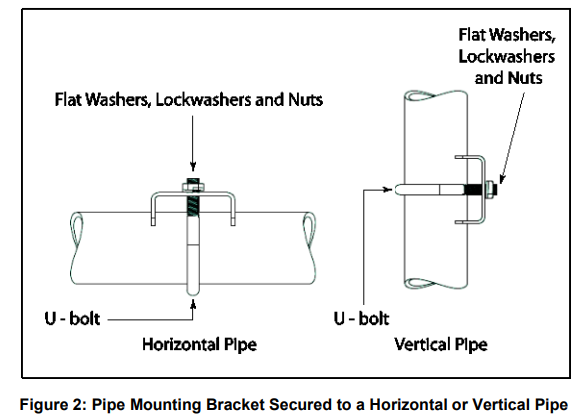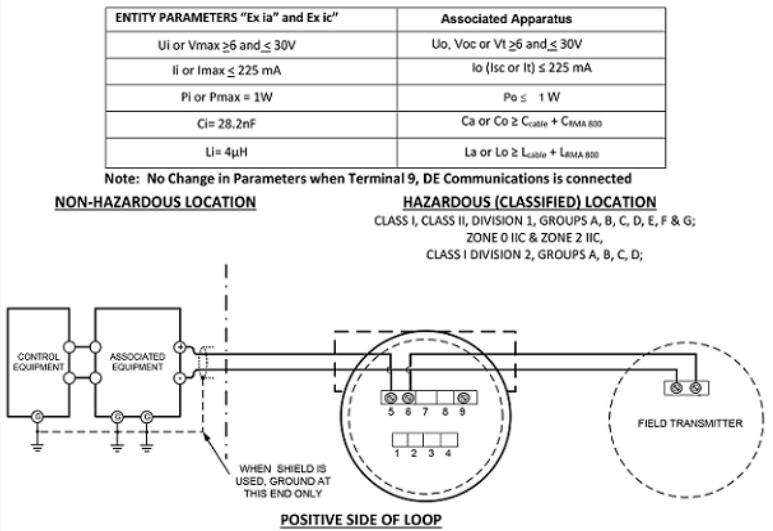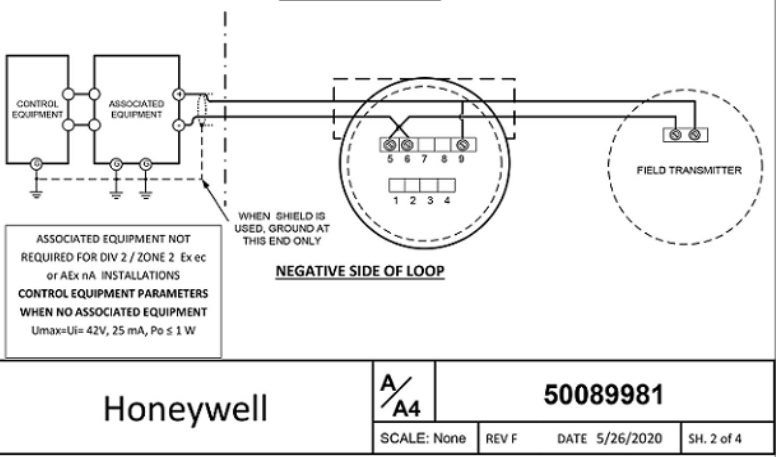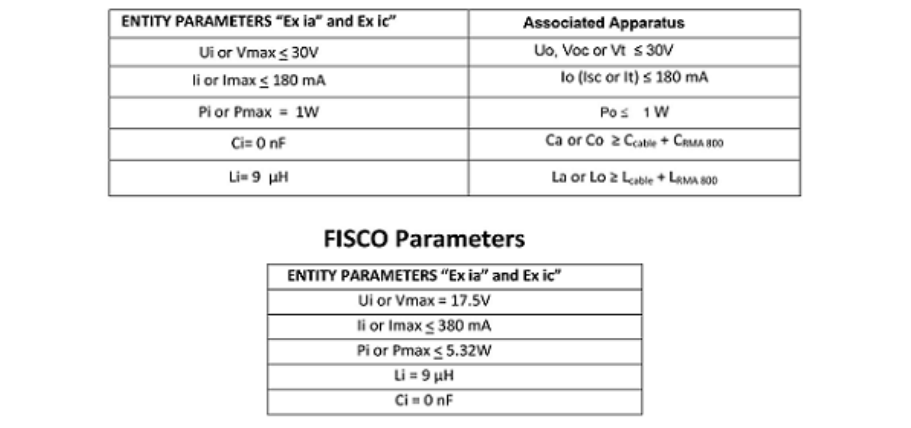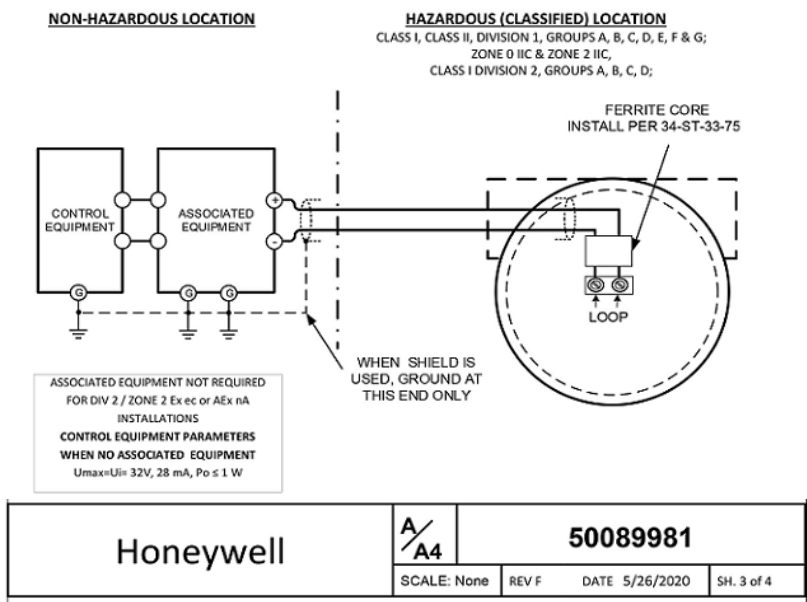
Honeywell RMA805 Enraf FlexLine Remote Indicator
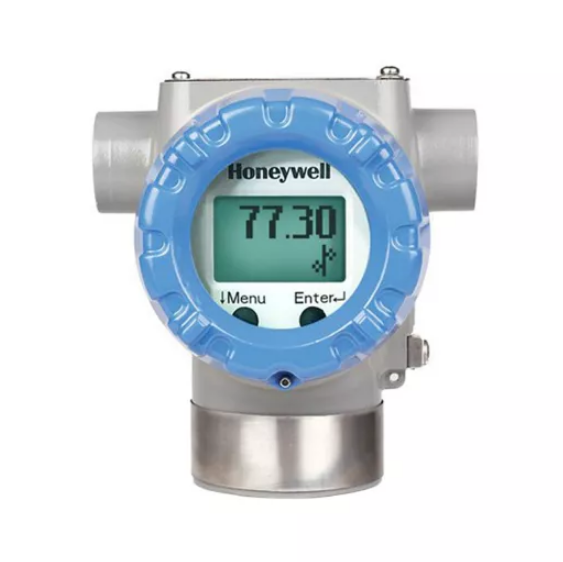
Installation and Startup
Installation Site Evaluation
Evaluate the site selected for the RMA805 Enraf FlexLine Remote Indicator installation with respect to the process system design specifications and Honeywell’s published performance characteristics for your particular model. Some parameters that you may want to include in your site evaluation are:
- Environmental Conditions:
- Ambient Temperature
- Relative Humidity
- Potential Noise Sources:
- Radio Frequency Interference (RFI)
- Electromagnetic Interference (EMI)
- Vibration Sources
- Motorized System Devices (e.g., pumps)
Display Installation Precautions
Temperature extremes can affect display quality. The display can go blank if the temperature is below -20°C or above +70°C; however, this is only a temporary condition. The display will again be readable when temperatures return to within operable limits.
Mounting Remote Indicator
Summary
Remote Indicator models can be attached to a two-inch (50 millimeter) vertical or horizontal pipe using Honeywell’s optional pipe mounting bracket. Honeywell’s optional wall mounting bracket is also shown below. Figure 1 shows typical bracket-mounted installations.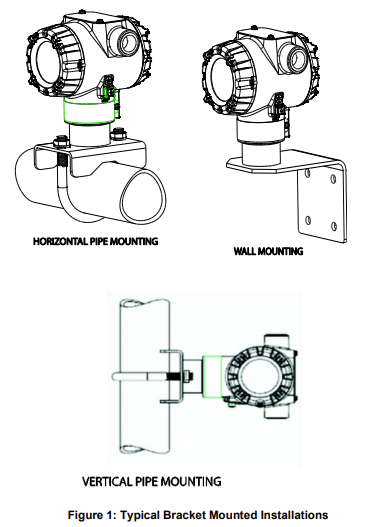
Mounting Dimensions
Refer to Honeywell drawing number 50094836 for detailed electronic housing dimensions. Refer to Honeywell drawing numbers 50095917 for detailed pipe mounting dimensions and 50095918 for detailed wall mounting dimensions. Abbreviated overall dimensions are also shown on the Specification Sheets for the Remote Indicator models. This section assumes that the mounting dimensions have already been taken into account and the mounting area can accommodate the Remote Indicator.
Bracket Mounting
If you are using an optional bracket, start with Step 1.
- Align the two mounting holes in the Remote Indicator with the two slots in the mounting bracket and assemble the (2) M8 hex cap screws, (2) lockwashers, and (2) flat washers provided. Rotate the Remote Indicator assembly to the desired position and torque the M8 hex cap screws to 27,0 Nm/20,0 Lb-ft maximum.
Pipe Mount Option: Refer to Figure 2
- Position the bracket on a 2-inch (50.8 mm) horizontal or vertical pipe, and install a “U” bolt around the pipe and through the holes in the bracket. Secure the bracket with the nuts, flat washers, and lock washers provided.
- Wall Mount Option: Position the bracket on the mounting surface at the desired location and secure the bracket to the mounting surface using the appropriate hardware (Wall mounting hardware requirements to be determined and supplied by the end user).

Wiring the RMA805 Enraf FlexLine Remote Indicator
Overview
The Remote Indicator must be connected to the local HART-compatible bus of the Enraf Smartradar FlexLine or the Enraf SmartServo 954. The Remote Indicator has 3 terminals. The following table provides the connection details:
- The screw terminals are suitable for wiring up to 16AWG (1.3 mm2). Shielded twisted pair cable, such as Belden 9318 or equivalent, must be used for all wiring.
- The cable shield must be connected at only one end of the cable. Connect it to the FlexLine Gauge side and leave the shield insulated at the Remote Indicator side.
Note: If solid core wire is used, strip insulation 1/4 in (6 mm). Once inserted under the square washer, the stripped portion should be contained under the square washer. If a multi-stranded wire is used, a ferrule is to be used, and the stripped wire should be in the insulated portion of the ferrule. The ferrule can also be used on the solid core wire.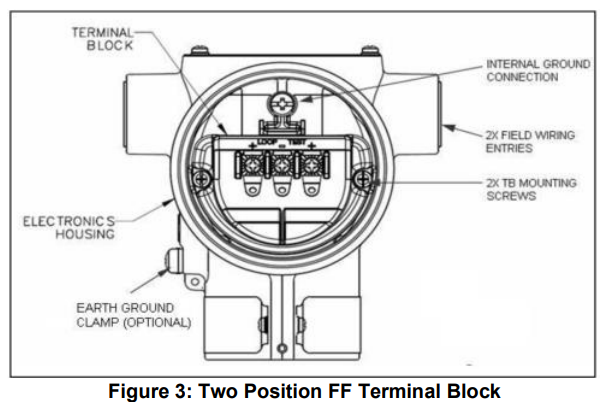
Electrical Wiring
The Remote Indicator shall be connected to the Loop + and Loop – terminals of the FlexLine Gauge. Typically, these are terminals 24 and 25. See the installation manual of the FlexLine Gauge for more information. It is possible that other devices, such as a VITO temperature converter and a pressure transmitter, must be connected to the same loop. All devices must be wired in parallel. Ensure all devices are set to 4 mA digital multi-drop mode before connecting to the FlexLine Gauge. See Figure 4 for a connection diagram.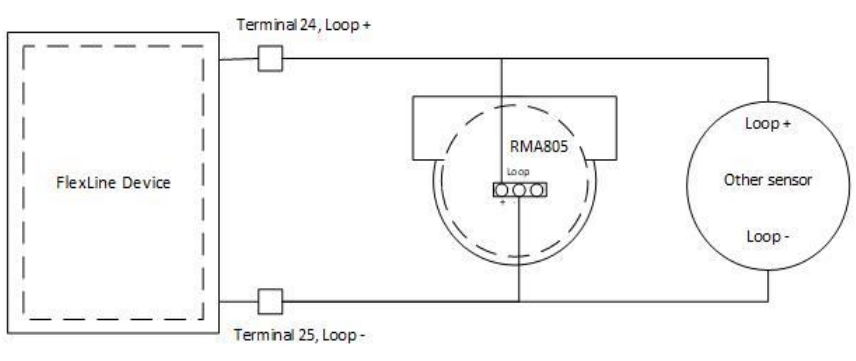
Wiring Procedure
- See Figure 3 for parts locations. Loosen the end cap lock using a 1.5 mm Allen wrench.
- Remove the end cap cover from the terminal block end of the electronics housing.
- Feed loop power leads through one end of the conduit entrances on either side of the electronics housing. The Remote Indicator accepts up to 16 AWG wire.
- Plug the unused conduit entrance with a conduit plug appropriate for the environment.
- Torque terminal screws to 0.6 Nm (5.3 lbf.in) to 0.8 Nm (7.0 lbf.in).
- Connect the Loop Power wiring shield to earth ground only at the power supply side.
- Replace the end cap and secure it in place, being careful not to damage the wires.
Explosion-Proof Conduit Seal
Remote Indicator installed as explosion-proof in Class I, Division 1, Group A Hazardous (classified) locations in accordance with ANSI/NFPA 70, the US National Electrical Code, with ½ inch conduit, does not require an explosion-proof seal for installation. If ¾ inch conduit is used, a LISTED explosion-proof seal must be installed in the conduit, within 18 inches (457.2 mm) of the Remote Indicator.
Jumper Settings
On the Remote Indicator, there is a failsafe jumper and a write-protect jumper behind the display on the Communication Module. The top jumper is the failsafe jumper. It is highly recommended to put the failsafe jumper to DOWN (Downscale). The bottom jumper sets the write protect.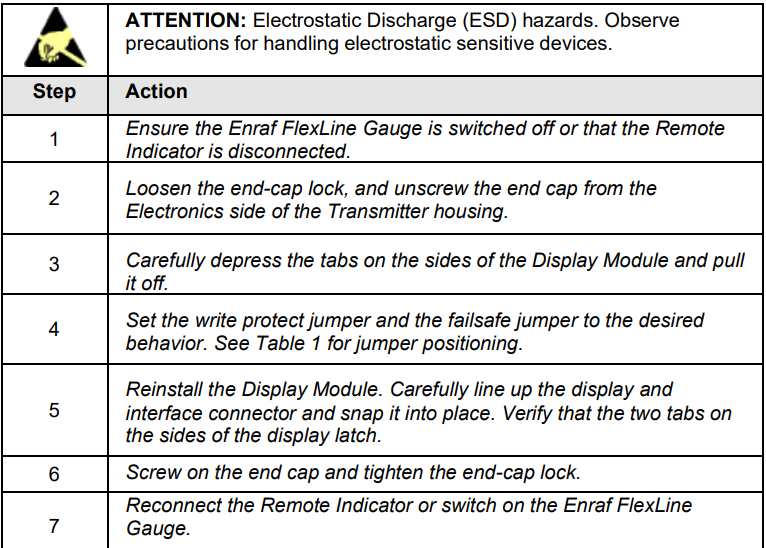
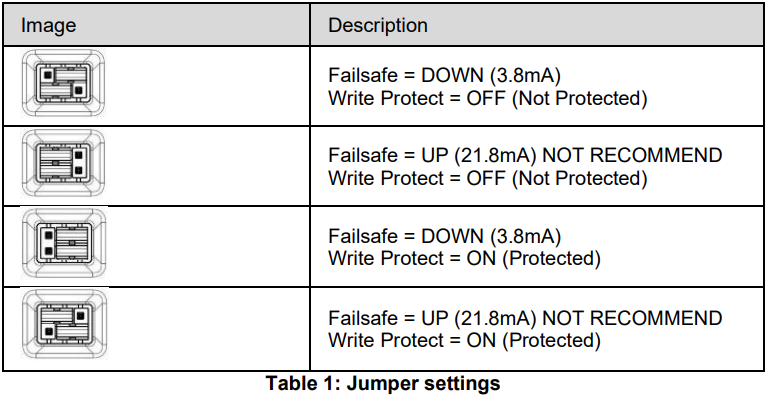
Configuration Guide
The Remote Indicator 3-button interface provides user interface and operation capability without opening the Remote Indicator. The user must press![]() the button to call up the Main Menu. To exit the Main Menu and return to the PV display screen, select <EXIT>. Use the
the button to call up the Main Menu. To exit the Main Menu and return to the PV display screen, select <EXIT>. Use the![]() button to scroll through the list of menu items. Press the
button to scroll through the list of menu items. Press the ![]() button to select an item for data entry or activation. When an item is selected for data entry or activation, the cursor is positioned over the left-most digit to allow editing of the value. No action is taken against a menu item until the
button to select an item for data entry or activation. When an item is selected for data entry or activation, the cursor is positioned over the left-most digit to allow editing of the value. No action is taken against a menu item until the ![]() button is pressed.
button is pressed.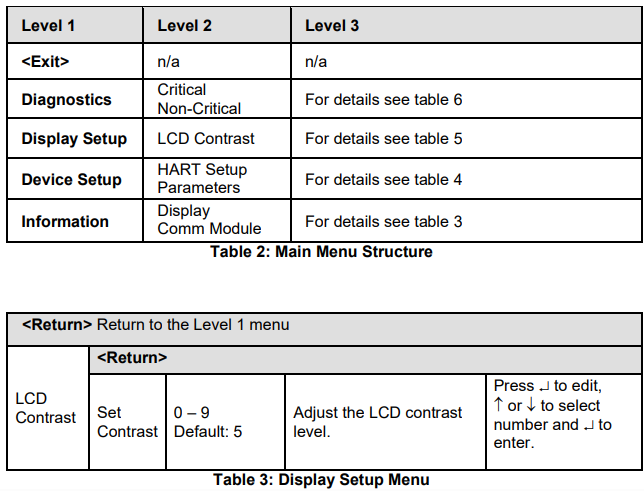

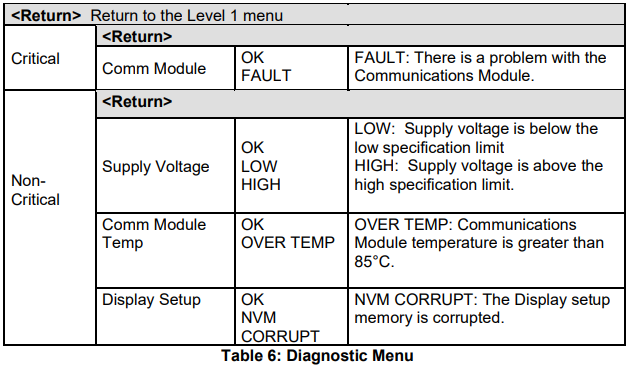
Appendix A. PRODUCT CERTIFICATIONS
A1. Hazardous Locations Certifications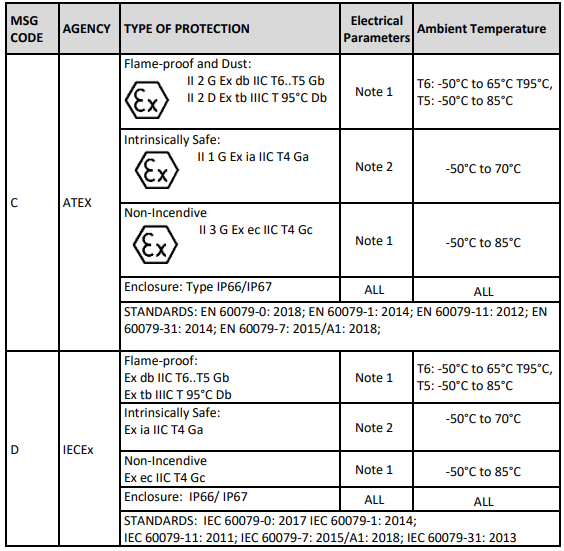
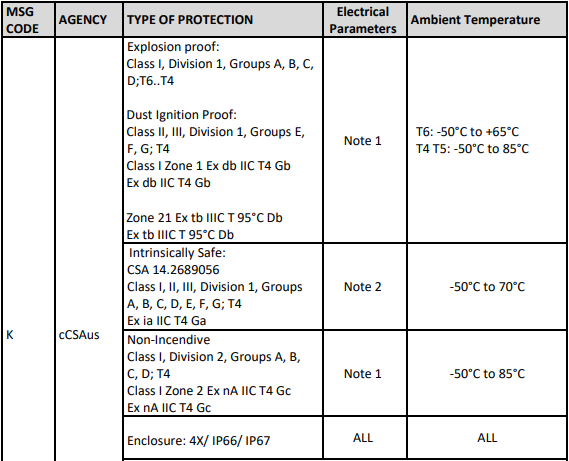

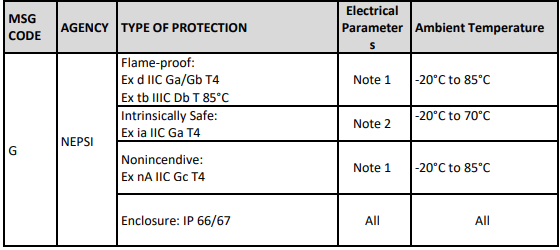
Notes
- Operating Parameters: Voltage= 12 to 42 V Current= 25 mA
- Intrinsically Safe Entity Parameters. For details, see Control Drawing, 50089981.
A2 Marking ATEX Directive
- General: The following information is provided as part of the labeling of the Remote Indicator: Name and Address of the manufacturer. The serial number of the Remote Indicator is located on the Meter Body data plate. The first two digits of the serial number identify the year (12) and the second two digits identify the week of the year (23); for example, 1223xxxxxxxx indicates that the product was manufactured in 2012, in the 23rd week.
- Apparatus Marked with Multiple Types of Protection. The user must determine the type of protection required for the installation of the equipment. The user shall then check the box [ ] adjacent to the type of protection used on the equipment certification nameplate. Once a type of protection has been checked on the nameplate, the equipment shall not then be reinstalled using any of the other certification types.
- WARNINGS and Cautions
- Non-Incendive / Non-Sparking (Division 2 and Zone 2 Environments): WARNING – EXPLOSION HAZARD – SUBSTITUTION OF COMPONENTS MAY IMPAIR SUITABILITY FOR CLASS I, DIVISION 2
- Intrinsically Safe (Divisions 1, Zone 1 and Zone 2 Environments): WARNING – EXPLOSION HAZARD – SUBSTITUTION OF COMPONENTS MAY IMPAIR INTRINSIC SAFETY.
- WARNING – DO NOT OPEN WHEN AN EXPLOSIVE GAS ATMOSPHERE IS PRESENT.
- Explosion-Proof (Division 1 and Zone 1 Environments): WARNING – DO NOT OPEN WHEN AN EXPLOSIVE GAS ATMOSPHERE IS PRESENT. WARNING – DO NOT OPEN WHEN ENERGIZED “OPEN CIRCUIT BEFORE REMOVING COVER”
- Flameproof (Division 1 and Zone 1 Environments): WARNING – DO NOT OPEN WHEN ENERGIZED
- General Requirements / Increased Safety (Zone 1): WARNING – DO NOT OPEN WHEN ENERGIZED
WARNING – OPEN CIRCUIT BEFORE REMOVING COVER - All Protective Measures: WARNING: FOR CONNECTION IN AMBIENTS ABOVE 60°C USE WIRE RATED 105°C
A.3 Conditions of Use” for Ex Equipment”, Hazardous Location Equipment, or “Schedule of Limitations”:
- Consult the manufacturer for dimensional information on the flameproof joints for repair.
- The painted surface of the RMA 800 series may store electrostatic charge and become a source of ignition in applications with a low relative humidity of less than approximately 30% relative humidity, where the painted surface is relatively free of surface contamination such as dirt, dust, or oil. Cleaning of the painted surface should only be done with a damp cloth.
- The ambient temperature range and applicable temperature class of the equipment are as follows: RMA805 series: T4 for -50˚C < Ta < 70˚C
- The RMA800 series enclosure contains aluminum and is considered to present a potential risk of ignition by impact or friction. Care must be considered during installation and use to prevent impact or friction to avoid impact.
- If a charge-generating mechanism is present, the exposed metallic part on the enclosure is capable of storing a level of electrostatic charge that could become incendiary for IIC gases. Therefore, the user/installer shall implement precautions to prevent the buildup of electrostatic charge, e.g,. earthing the metallic part. This is particularly important if the equipment is installed in a zone 0 location.
- On installation, the RMA800 series shall be provided with supply transient protection external to the apparatus such that the voltage at the supply terminals of the RMA800 series does not exceed 140% of the voltage rating of the equipment. However, when an RMA805 is connected to a SmartRadar FlexLine or to a SmartServo 954, the supply transient protection is included in the SmartRadar FlexLine or SmartServo 954.
A.4 Control Drawing
RMA 800 Series Remote Meter Analog, DE Communications, Foundation Fieldbus and ENRAF FLEXLINE Communications
- Intrinsically safe installation shall be in accordance with:
- FM (USA): ANSI/NFPA 70, NEC Articles 504 and 505.
- CSA (Canada): Canadian Electrical Code (CEC), part I, section 18.
- ATEX: Requirements of EN 60079-14, 12.3 (See also 5.2.4).
- IECEx: Requirements of IEC 60079-14, 12.3 (See also 5.2.4).
- ENTITY-approved equipment shall be installed in accordance with the manufacturer’s Intrinsic Safety Control Drawing.
- The Intrinsic Safety ENTITY concept allows the interconnection of two ENTITY Approved Intrinsically safe devices with ENTITY parameters not specifically examined in combination as a system when:
- Uo, Voc, or Vt ≤ Uior Vmax; Io, Isc, or It ≤ Ii or Imax; Ca or Co ≥ Ci + Ccable, La or Lo ≥ Li + Lcable, Po ≤ Pi. Where two separate barrier channels are required, one dual-channel or two single-channel barriers may be used, where in either case, both channels have been certified for use together with combined entity parameters that meet the above equations.
- System Entity Parameters:
- RMA 800 Remote Meter: Vmax Voc or Uo, Imax Isc or Io
- RMA 800 Remote Meter: Ci + Ccable ≤ Control Apparatus Ca
- RMA 800 Remote Meter: Li + Lcable ≤ Control Apparatus La
- When the electrical parameters of the cable are unknown, the following values may be used:
- Capacitance: 197pF/m (60 pF/ft)
- Inductance: 0.66uH/m (0.020uH/ft)
- Control equipment that is connected to Associated Equipment must not use or generate more than 250 V. Associated equipment must be FM, CSA, ATEX, or IECE (depending on location) listed. Associated equipment may be installed in a Class I, Division 2 or Zone 2 Hazardous (Classified) location if so approved.
- Non-Galvanically isolated equipment (grounded Zener Barriers) must be connected to a suitable ground electrode per:
- FM (USA): NFPA 70, Articles 504 and 505. The resistance of the ground path must be less than 1.0 ohms.
- CSA (Canada): Canadian Electrical Code (CEC), part I, section 10.
- ATEX: Requirements of EN 60079-14, 12.2.4.
- IECEx: Requirements of IEC 60079-14, 12.2.4.
- Intrinsically Safe DIVISION 1/ Zone 0 WARNING: SUBSTITUTION OF COMPONENTS MAY IMPAIR SUITABILITY FOR USE IN HAZARDOUS LOCATIONS.
- Division 2/ Zone 2: WARNING: DO NOT OPEN WHEN AN EXPLOSIVE GAS ATMOSPHERE IS PRESENT.
- NO REVISION OF THIS CONTROL DRAWING IS PERMITTED WITHOUT AUTHORIZATION FROM THE AGENCIES listed.
- For release approvals, see ECO-0103558.

RMA801, Analog/ DE Communications


RMA803, Foundation Fieldbus


RMA805, ENRAF FLEXLINE COMMUNICATIONS
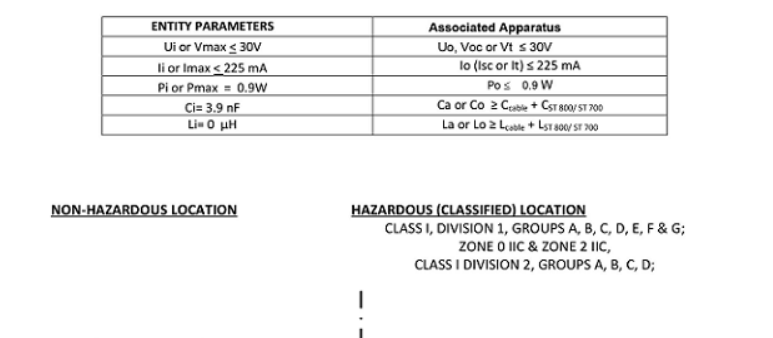
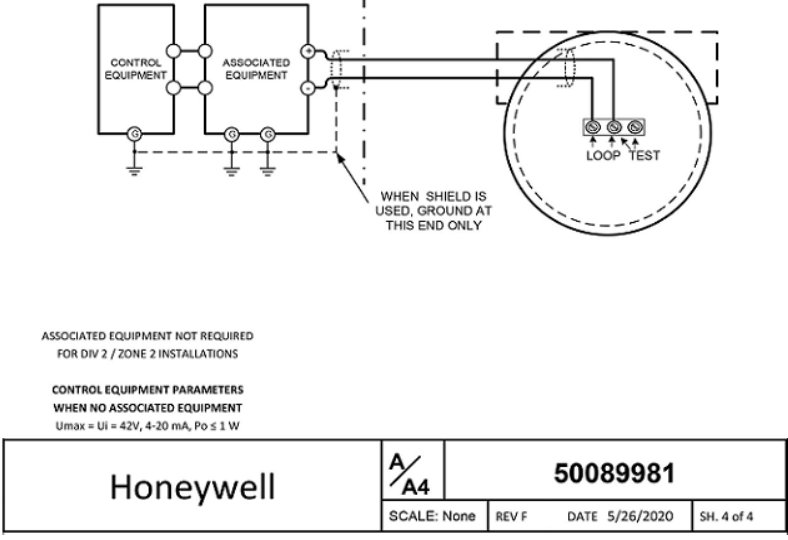
Sales and Service
For application assistance, current specifications, pricing, or the name of the nearest Authorized Distributor, contact one of the offices below.
- ASIA PACIFIC
- Honeywell Pte Ltd.
- 17 Changi Business Park Central 1
- Singapore 486073
- Phone: +65 6355 2828
- Email: (Sales) [email protected] or (TAC) [email protected]
- Web Knowledge Base search engine http://bit.ly/2N5Vldi
- EMEA
- Honeywell Enraf
- Delftechpark 39
- 2628 XJ Delft
- The Netherlands
- Phone: +31 (0)15 2701 100
- Email: (Sales) [email protected] (TAC) [email protected]
- Web Knowledge Base search engine http://bit.ly/2N5Vldi
- Americas
- Honeywell Enraf Americas, Inc.
- 1250 West Sam Houston Pkwy S.
- Houston, TX 77042,
- USA
- Phone: +1 (480) 293-2042
- Email: (Sales)
- Email: [email protected] or (TAC) [email protected]
- Web Knowledge Base search engine http://bit.ly/2N5Vldi
WARRANTY/REMEDY
Honeywell warrants goods of its manufacture as being free of defective materials and faulty workmanship. Contact your local sales office for warranty information. If warranted goods are returned to Honeywell during the period of coverage, Honeywell will repair or replace without charge those items it finds defective. The foregoing is Buyer’s sole remedy and is in lieu of all other warranties, expressed or implied, including those of merchantability and fitness for a particular purpose. Specifications may change without notice. The information we supply is believed to be accurate and reliable as of this printing. However, we assume no responsibility for its use. While we provide application assistance personally, through our literature and the Honeywell website, it is up to the customer to determine the suitability of the product in the application.
For More Manuals By Honeywell, Visit ManualsLibraryy.
Honeywell RMA805 Enraf FlexLine Remote Indicator-FAQs
What does the RMA805 do?
It provides a remote digital readout of level, volume, or percentage from an Enraf FlexLine tank gauge.
What’s the first safety step before wiring?
Disconnect power to both the gauge and the RMA805 indicator and follow all site safety procedures.
How is it connected to the gauge?
Via a dedicated shielded cable. Correct terminal wiring per the manual’s diagram is critical.
How do I set it up?
Apply power, then use the front buttons to configure its communication settings to match the FlexLine gauge’s address.
What if it shows an error or no data?
Check: 1) Power supply, 2) Communication cable connections, 3) That the address matches the gauge.
Does it have a 4-20mA output?
Yes, it can be configured to provide a 4-20mA analog output signal.
What maintenance is needed?
Routine visual inspection for damage and verification of reading accuracy.
Where are the full instructions?
Always consult the official Honeywell Manual (Doc: 42/24-25-11 EN) for complete, authoritative guidance.


